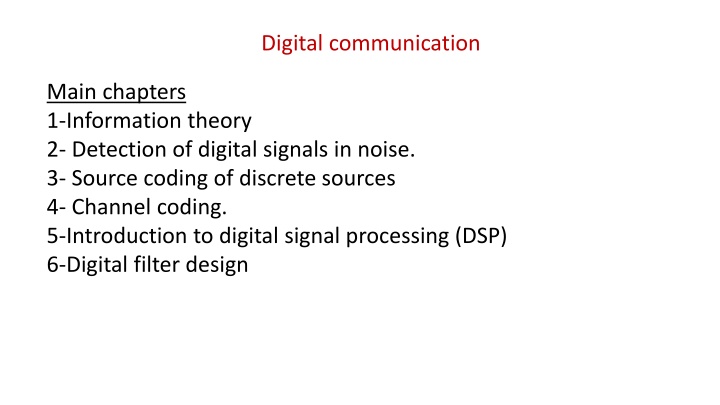
Information Theory in Digital Communication
Explore the fundamentals of information theory in digital communication, covering topics such as self-information, source entropy, and more. Gain insights into how information is transmitted, encoded, and decoded in communication systems.
Download Presentation

Please find below an Image/Link to download the presentation.
The content on the website is provided AS IS for your information and personal use only. It may not be sold, licensed, or shared on other websites without obtaining consent from the author. If you encounter any issues during the download, it is possible that the publisher has removed the file from their server.
You are allowed to download the files provided on this website for personal or commercial use, subject to the condition that they are used lawfully. All files are the property of their respective owners.
The content on the website is provided AS IS for your information and personal use only. It may not be sold, licensed, or shared on other websites without obtaining consent from the author.
E N D
Presentation Transcript
Digital communication Main chapters 1-Information theory 2- Detection of digital signals in noise. 3- Source coding of discrete sources 4- Channel coding. 5-Introduction to digital signal processing (DSP) 6-Digital filter design
INFORMATION THEORY : this subject deals with information or data transmission from one point to another The block diagram for any communication system is : Source of information Listener or receptor encoder channel decoder modulation demodulation speaker Audio Video Telex TV ciphering deciphering computer typewriter Error detection and correction decompression Error correction computer compression The concept of information is related to probability. Any signal that conveys information must be unpredictable (random), but not visa versa, i.e. not any random signal conveys information.(noise is a random signal conveying no information).
Self Information ?1 ----------?(?1) ?2------------?(?2) ?3------------?(?3) Source of information . . n = i = ( ) 1 p ix ??------------?(??) 1 source produces the message xiis related with p(xi) as follows: 1-information is zero if p(xi)=1 (certain event) 2-information increases as p(xi) decreases to zero. 3-information is a +ve quantity. The function that relates p(xi) with information of xiis denoted by I(xi) and is called self information of xi. The log function shown satisfies all previous three points hence: = ( ) log p(xi) I ix Where a=2, then the unit of I(xi) is bit a
Ex: A fair die is thrown, find the amount of information gained if you are told that 4 will appear. Solution: Since fair, die then, p(1)=p(2)= .=p(6)=1/6, then: I(4)=-log2p(4)=-log2(1/6)=ln6/ln2=2.5849 bits. Ex: A biased coin has p(Head)=0.3. Find the amount of information gained if you are told that a tail will appear. Solution: P(tail)=1-p(Head)=1-0.3=0.7, then I(tail)=-log2(0.7)=-ln0.7/ln2=0.5145 bits. Ex: Find the amount of information contained in a black & white (B/W) TV picture if we assume that each picture has 2*105dots (pixels or picture elements) and each pixel has 8 equiprobable and distinguishable levels of brightness. Solution: P(each level)=1/8 since equiprobable levels Information/pixel=-log2(1/8)=3 bits Information/picture=Information/pixel * no. of pixels =3 * 2* 105=600 kbits. pixel
Homework: Repeat previous example for color TV with 16 equiprobable colors and 8 equiprobable levels of brightness. Source Entropy ?1 ----------?(?1) ?2------------?(?2) If the source produces not equiprobable messages then I(xi) , i=1,2, ..,n, are different. Then the statistical average of I(xi) over i will give the average amount of uncertainty associated with the source X. This average is the called source entropy and is denoted by H(X). ?3------------?(?3) Source of information . . This H(X) is given by: ??------------?(??) n = i = ( ) ( ) ( ) H X p xi I xi 1 or
Ex: Find the entropy of the source producing the following messages: 1 2 3 4 x x x x = ( ) p X . 0 25 1 . 0 . 0 15 5 . 0 Solution: 4 = i = ( ) ( ) log ( ) H X p xi p xi 2 1 H(X)=-[0.25ln0.25+ 0.1ln0.1+ 0.15ln0.15+0.5ln0.5]/ln2 H(X)=1.7427 bits/symbol Ex: Find and plot the entropy of a binary source. Solution : p(0T)+p(1T)=1, hence: 0, p(0T) Binary source 1, p(1T) H(X)=-[ p(0T) log2p(0T)+ (1- p(0T)) log2(1- p(0T))] bits/symbol Note that H(X) is maximum equals 1 bit if p(0T)=p(1T)=0.5
Notes: 1-In general H(X)=H(X)|max=log2n bits/symbol if all messages are equiprobable, i.e, p(xi)=1/n, then : 2-H(X)=0 if one of the messages has the prob of a certain event. SOURCE ENTROPY RATE This is the average rate of amount of information produced per second. It is denoted by R(X) and is given by: 1) R(X)= H(X) * rate of producing the symbols average time duration of symbols, iis the time duration of the symbol xi.
Ex:A source produces dots "." and dashes "" with p(dot)=0.65. If the time duration of a dot is 200ms and that for a dash is 800ms. Find the average source entropy rate. Solution: P(dot)=0.65, then p(dash)=1-p(dot)=1-0.65=0.35. H(X)=-[0.65 log20.65 + 0.35 log20.35]=0.934 bits/symbol dot=0.2 sec, dash=0.8 sec, then = 8 . 0 + = 2 . 0 . 0 * 65 . 0 * 35 . 0 41 sec ( ) . 0 934 H X = = = ( ) . 2 278 then R X bps . 0 41
Ex: In a telex link, information is arranged in blocks of 8 characters. The 1stposition(character) in each block is always kept the same for synchronization purposes . The remaining 7 places are filled randomly from the English alphabets with equal prob. If the system produces 400 blocks/sec, find the average source entropy rate. Information/position= - log2(1/26)=log226=4.7 bits Information/block=7 * 4.7 =32.9 bits, we exclude the 1stcharacter since it has no information having the prob of certain event (contains synch only) Then: R(X)=Information/blocks * rate of producing blocks/sec =32.9 *400=13160 bits/sec Sheet1: Q1 , Q2, Q3, Q4, Q 5, Q7, Q 8, Q9, Q 11, Q 28, Q 21
Joint and conditional probabilities: ? ? Left handed y1 Right handed y2 ? ??,?? = 1 Joint or system probability ?=1 ?=1 Male (x1) 80 180 0.36 0.16 0.52 Female (x2) 0.26 110 0.22 0.48 130 500 1 0.42 0.58
MUTUAL INFORMATION: The mutual information between two random variables measures the amount of information that one conveys about the other. Tx Noise jamming Rx x1, x2, ..,xn, are the set of symbols that transmitter Txmay produce. X1 X2 X3 . . . Xn Y1 Y2 Y3 . . . Ym receiver Rxmay receive y1,y2, ,ym. channel if the noise and jamming is zero, then the set X=set Y and n=m. However, and due to noise and jamming, there will be a conditional probability p(yj/xi):Define 1-p(xi) to be what is called the apriori prob of the symbol xi, which is the prob of selecting xifor transmission. 2-p(xi/yj) to be what is called the aposteriori prob of the symbol xiafter the reception of yj. The amount of information that yjprovides about xiis called the mutual information between xiand yj
since p(xi) p(yj/xi)=p(yj) p(xi/yj)=p(xi,yj), then: the mutual information is symmetric. Note: p(xi/yj) p(yj/xi) in general. In fact, p(yj/xi) gives the prob of yjgiven that xiis transmitted, as if we are at the Txand we transmit xiand we ask about the prob of receiving yjinstead. The prob p(xi/yj) is the prob of xi given we receive yjas if we are at the Rxand we receive yjand we ask about if it was coming from xi. Properties of I(xi,yj): 1-it is symmetric, i.e. I(xi,yj)=I(yj,xi) 2- I(xi,yj)>0 if aposteriori prob> apriori prob, yjprovides +ve information about xi. 3- I(xi,yj)=0, if aposteriori prob =apriori prob, which is the case of statistical independence when yjprovides no information about xi. 4- I(xi,yj)<0 if aposteriori prob< apriori prob, yjprovides -ve information about xi, i.e., yjadds ambiguity.
Transformation(average mutual information: This is the statistical averaging of all the pair I(xi,yj), i=1,2, n, j=1,2,3 m. This is denoted by I(X,Y) and is given by:
Marginal Entropies Marginal entropies are a term usually used to denote both source entropy H(X) defined as before and the receiver entropy H(Y) given by:
Joint and conditional entropies: Joint or system entropy: The average amount of information associated with the pair (xi,yj) is called joint or system entropy H(X,Y): conditional entropies H(Y/X) & H(X/Y):The average amount of information associated with the pairs (yj/xi) & (xi/yj) 1) Noise entropy: average amount of uncertainty or information about y that remains if we are first told x 2) Losses entropy: average amount of uncertainty or information that remains about x when y is known
1) H(X,Y)=H(X)+H(Y/X) 2) H(X,Y) = H(Y) + H(X/Y) 3) I(X,Y)= H(X)- H(X/Y) 4) I(X,Y) = H(Y)- H(Y/X)
Then: Then: Note : H(Y/X) H(X/Y) Ex: Show that H(X,Y)=H(X)+H(Y/X) Solution: This is a very useful identity to ease calculations in problem solving. To prove it, then we know that: = = j i 1 1 m n = ( , ) ( , ) log ( , ) H X Y p xi yj p xi yj 2 But p(xi,yj)=p(xi) p(yj/xi), putting this inside the log term only, then: m n m n = j 1 = j 1 = ( , ) ( , ) log ( ) ( , ) log ( / ) H X Y p xi yj p xi p xi yj p yj xi 2 2 = = 1 1 i i m = = ( , ) ( ) p xi yj p xi After reversing the order of summation, then 1 j n n m = i = i 1 = ( , ) ( ) log ( ) ( , ) log ( / ) H X Y p xi p xi p xi yj p yj xi 2 2 = 1 1 j
In the above equation, the 1stterm is in fact H(X) and the 2ndterm with - sign is H(Y/X), then: H(X,Y)=H(X)+H(Y/X) Homework: Show that H(X,Y)=H(Y)+H(X/Y) Ex: Show that I(X,Y)=H(X)-H(X/Y)
Homework: Show that I(X,Y)=H(Y)-H(Y/X) Ex: Show that I(X,Y) is zero for extremely noisy channel. Solution: For extremely noisy channel, then yjgives no information about xi( the receiver can not decide anything about xias if we transmit a deterministic signal xibut the receiver receives noiselike signal yjthat is completely has no correlation with xi). Then xiand yjare statistically independent and p(xi/yj)=p(xi) and p(yj/xi)=p(yj) for all i and j , then: I(xi,yj)=log21=0 for all i & j , then I(X,Y)=0
1-marginal entropies. 2-joint entropy. 3-conditional entropies. 4-the mutual information between x1and y2. 5-the transinformation. 6-then draw the channel model.
Homework: For the channel model shown, Find:1-source entropy rate if x1=1ms and x2=2ms, I(x1)=2bits. 2-the transinformation






















